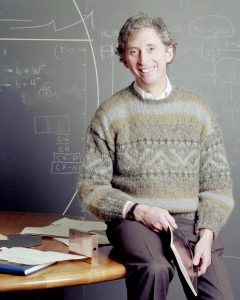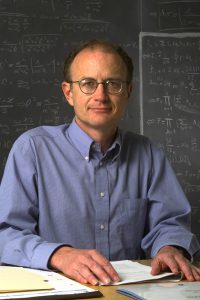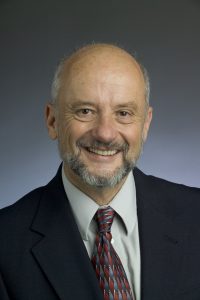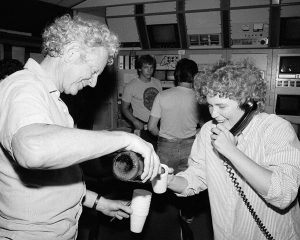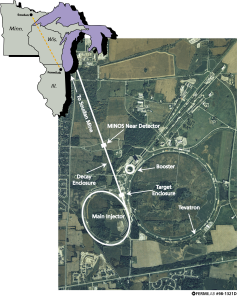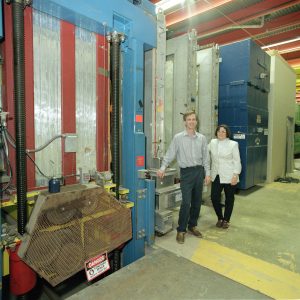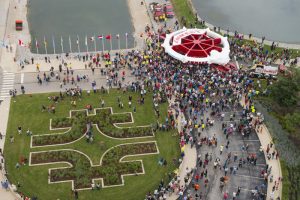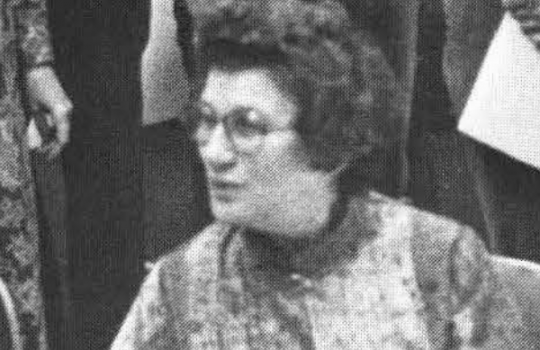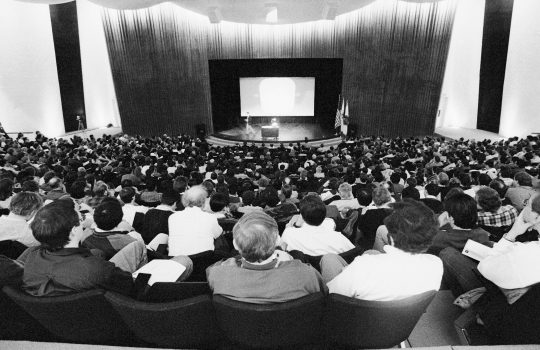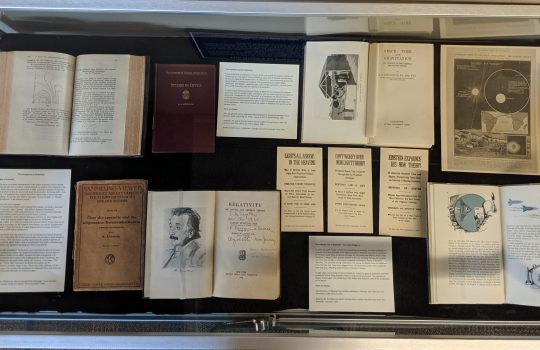July brought Fermilab three new directors, two discovery announcements and one big, red ring. Read on for more July historical milestones.
July 1989: Peoples becomes lab director
In July 1989, John Peoples replaced Leon Lederman as Fermilab’s director. Peoples had joined the lab in 1971. He served as head of the Research Division and the Accelerator Division and oversaw the Antiproton Source, a key part of the Tevatron.
In July 1989, John Peoples replaced Leon Lederman as Fermilab’s director. Peoples had joined the lab in 1971. He served as head of the Research Division and the Accelerator Division and oversaw the Antiproton Source, a key part of the Tevatron.
July 1, 1999: Witherell becomes lab director
On July 1, 1999, Michael Witherell became Fermilab’s fourth director. He had worked at Fermilab on an experiment studying charm quarks in the 1980s and was a professor at the University of California, Santa Barbara, when he accepted the Fermilab directorship.
On July 1, 1999, Michael Witherell became Fermilab’s fourth director. He had worked at Fermilab on an experiment studying charm quarks in the 1980s and was a professor at the University of California, Santa Barbara, when he accepted the Fermilab directorship.
July 1, 2005: Oddone becomes lab director
Pier Oddone became Fermilab’s fifth director on July 1, 2005. Originally from Peru, he was serving as deputy director at Lawrence Berkeley National Lab when he became Fermilab’s director and won the 2005 W.K.H. Panofsky Prize in experimental particle physics.
Pier Oddone became Fermilab’s fifth director on July 1, 2005. Originally from Peru, he was serving as deputy director at Lawrence Berkeley National Lab when he became Fermilab’s director and won the 2005 W.K.H. Panofsky Prize in experimental particle physics.
July 3, 1983: Tevatron reaches world record energy
The Tevatron surpassed its design energy of 500 GeV within 13 hours of the first attempt to accelerate the beam. It reached a world record proton beam energy of 512 GeV on July 3, 1983.
The Tevatron surpassed its design energy of 500 GeV within 13 hours of the first attempt to accelerate the beam. It reached a world record proton beam energy of 512 GeV on July 3, 1983.
July 4, 2012: Discovery of the Higgs boson
On July 4, 2012, scientists with CERN’s CMS and ATLAS experiments announced the discovery of the Higgs Boson, a particle that had been predicted by theorists and is responsible for giving other particles mass. Fermilab plays a significant role in the CMS experiment, and many Fermilab scientists contributed to the discovery.
On July 4, 2012, scientists with CERN’s CMS and ATLAS experiments announced the discovery of the Higgs Boson, a particle that had been predicted by theorists and is responsible for giving other particles mass. Fermilab plays a significant role in the CMS experiment, and many Fermilab scientists contributed to the discovery.
July 20, 1999: MINOS detector hall groundbreaking
MINOS, the Main Injector Neutrino Oscillation Search, was Fermilab’s first long-baseline neutrino experiment. It was designed to observe the phenomenon of neutrino oscillations, an effect that is related to neutrino mass. The groundbreaking for the MINOS detector hall in the Soudan Mine near Tower, Minnesota, was held on July 20, 1999, marking the beginning of the lab’s transition from the Tevatron era to the neutrino era.
MINOS, the Main Injector Neutrino Oscillation Search, was Fermilab’s first long-baseline neutrino experiment. It was designed to observe the phenomenon of neutrino oscillations, an effect that is related to neutrino mass. The groundbreaking for the MINOS detector hall in the Soudan Mine near Tower, Minnesota, was held on July 20, 1999, marking the beginning of the lab’s transition from the Tevatron era to the neutrino era.
July 21, 2000: Direct evidence of the tau neutrino
The Fermilab DONUT collaboration, which recorded data with a Tevatron fixed-target experiment in 1997, announced the first direct evidence for the tau neutrino on July 21, 2000.
The Fermilab DONUT collaboration, which recorded data with a Tevatron fixed-target experiment in 1997, announced the first direct evidence for the tau neutrino on July 21, 2000.
July 26, 2013: Muon g-2 ring arrives
Fermilab and Brookhaven National Laboratory transported a 50-foot-wide particle storage ring from Brookhaven in Long Island, New York, to Fermilab so it could be reused in Fermilab’s Muon g-2 experiment. The move began on June 22, and the ring traversed over 3,200 miles of land and water on its 35-day journey. About 3,000 people came to Fermilab on July 26, 2013, to watch it arrive.
Fermilab and Brookhaven National Laboratory transported a 50-foot-wide particle storage ring from Brookhaven in Long Island, New York, to Fermilab so it could be reused in Fermilab’s Muon g-2 experiment. The move began on June 22, and the ring traversed over 3,200 miles of land and water on its 35-day journey. About 3,000 people came to Fermilab on July 26, 2013, to watch it arrive.

